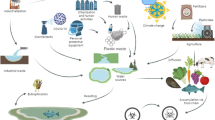Abstract
The structure of mathematical models for studying the processes of thermodynamics and transfer of pollutants in a climatic system involving the atmosphere of an industrial region and a lake is presented. These models are used to solve the problems of climatic and ecological monitoring and prediction. The problems of constructing numerical schemes and simulation methods are discussed. An example for estimating the effect of pollutants from sources located in the northern hemisphere of the Earth on the Baikal region is given.
Similar content being viewed by others
References
V. V. Penenko, A. E. Aloyan, N. M. Bazhin, et al., “Estimation of anthropogenic action on the Baikal region by means of numerical simulation,”Meteorol. Gidrol., No. 7, 78–84 (1989).
V. V. Penenko,Methods of Numerical Simulation of Atmospheric Processes [in Russian], Gidrometeoizdat, Leningrad (1981).
V. V. Penenko and A. E. Aloyan,Models and methods for Problems of Environmental Protection [in Russian], Nauka, Novosibirsk (1985).
V. V. Penenko and E. A. Tsvetova, “The adjoint problem and sensitivity algorithms for modeling of atmospheric hydrodynamics in sigma-coordinates,”Bull. NCC, Num. Model. Atmosph., No. 2, 53–74 (1995).
V. V. Penenko, “Numerical methods of model quality estimations and assimilation of observations,”Bull. NCC, Num. Model. Atmosph., No. 1, 69–90 (1993).
V. V. Penenko, “Some aspects of mathematical modeling using models together with observation data,”Bull. NCC, Num. Model. Atmosph., No. 4, 32–51 (1996).
E. A. Tsvetova,Mathematical Simulation of Circulation of Baikal Waters. Flows in Lake Baikal [in Russian], Nauka, Novosibirsk (1977).
E. A. Tsvetova, “Numerical model of dynamics and thermal regime of lake Baikal,” in: G. I. Marchuk and A. S. Sarkisyan (eds.),Mathematical Models of Circulation in the Ocean [in Russian], Nauka, Novosibirsk (1980), pp. 256–272.
V. V. Penenko, E. A. Tsvetova, G. I. Skubnevskaya, et al., “Numerical simulation of chemical kinetics and transfer of pollutants in the atmosphere of industrial regions,”Khim. Interes. Ustoich. Razv.,5, No. 5, 505–510 (1997).
V. V. Penenko and L. I. Kurbatskaya, “The study of dynamics of the “heat island” with account of interaction of radiation processes with aerosols,”Opt. Atmos. Okeana, No. 6, 581–585 (1998).
L. V. Ovsyannikov, “Equations of dynamic convection of the sea,” Preprint. Inst. Hydrodynamics, Sib. Div., USSR Acad. Sci., Novosibirsk (1967).
R. A. Pielke,Mesoscale Meteorological Modeling, Academic Press, New York (1984).
W. Kolemann (ed.),Prediction Methods for Turbulent Flows, Hemisphere, Washington (1980).
R. H. Langland and C. Liou, “Implementation of an (E-ɛ) parametrization of vertical sugrid-scale mixing in a regional model,”Month. Weather Review,124, No. 5, 905–918 (1996).
J. F. Geleyn and A. Hollingworth, “An economical analytical method for the computation of the interaction between scattering and line absorption of radiation,”Beitr. Phys. Atmosph.,52, No. 1, 1–16 (1979).
E. Kalnay, M. Kanamitsu, R. Kisler, et al., “The NCEP/NCAR 40-year reanalysis project,”Bull. Amer. Meteorol. Soc.,77, 437–471 (1996).
Additional information
Institute of Computational Mathematics and Mathematical Geophysics, Siberian Division, Russian Academy of Sciences, Novosibirsk 630090. Translated from Prikladnaya Mekhanika i Tekhnicheskaya Fizika, Vol. 40, No. 2, pp. 137–147, March–April, 1999.
Rights and permissions
About this article
Cite this article
Penenko, V.V., Tsvetova, E.A. Mathematical models for the study of interactions in the system lake baikal-atmosphere of the region. J Appl Mech Tech Phys 40, 308–316 (1999). https://doi.org/10.1007/BF02468528
Received:
Issue Date:
DOI: https://doi.org/10.1007/BF02468528




